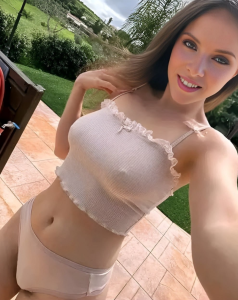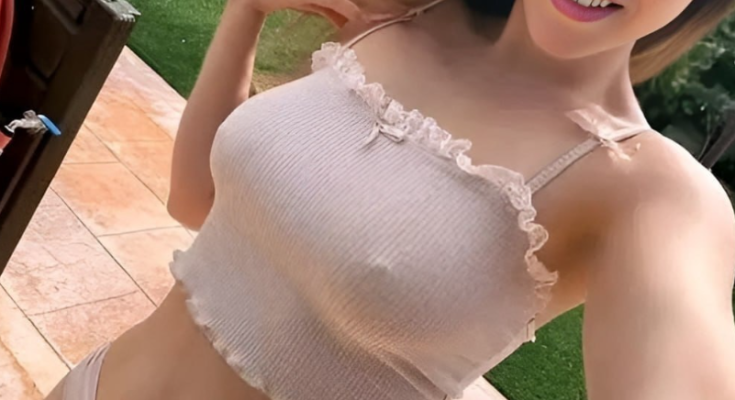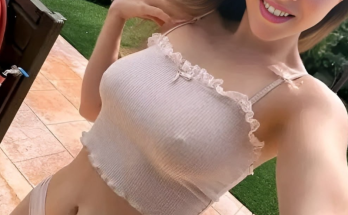The Pink Hour
She didn’t plan to take the photo. It just happened—like most things lately. The light was soft, the clouds were indecisive, and the hills in the distance looked like they were holding their breath. She stood on the patio in her ruffled pink top, the kind she hadn’t worn in years. It felt too young, too hopeful. But today, she wore it anyway.
The camera caught her mid-thought. Not smiling. Not frowning. Just… suspended. Like the sky behind her.
She hadn’t told anyone she was here. The house belonged to her aunt, who had left for Europe with a new husband and a suitcase full of silk scarves. “Stay as long as you need,” she’d said. “Just don’t rearrange the books.”
So she came. With a duffel bag, a notebook, and a heart that felt like it had been folded too many times.
Day One: The Silence
The silence was the first thing she noticed. Not the absence of sound, but the absence of expectation. No one asking what’s next. No one watching her eat cereal for dinner. No one measuring her grief against their own.
She walked barefoot across the tiles, letting the coolness ground her. The grass beyond the patio was wild, untrimmed, full of secrets. She liked it that way.
Day Three: The Ritual
She began taking a photo each morning. Same spot. Same angle. Different light. It became a ritual—not for vanity, but for proof. Proof that she existed. That she was still here, even if no one was watching.
She didn’t post them. She didn’t even look at them. She just saved them in a folder called “Pink Hour.”
Day Five: The Stranger
He appeared on the edge of the property, near the trees. Not close enough to be threatening. Just close enough to be noticed.
He wore black. Not biker black. Not funeral black. Just… deliberate black. He carried a camera, too. Not a phone. A real one. With a strap and a lens that looked like it could see through time.
She didn’t wave. He didn’t speak. But the next morning, he was there again.
Day Seven: The Conversation
“Nice light,” he said.
She nodded.
“I’ve been photographing the hills,” he added. “They change every day.”
“So do people,” she replied.
He smiled. “You’re not from here.”
“No one is,” she said.
Week Two: The Exchange
They began trading images. Not in person. He left prints on the patio table. She left hers in the mailbox. No names. No captions. Just moments.
His photos were wide, sweeping, full of distance. Hers were close, cropped, full of feeling.
Together, they told a story neither of them could write alone.
Week Three: The Letter
She found it tucked into one of his prints. A note, handwritten, folded twice.
“You look like someone who’s trying to remember something important. I don’t know what it is, but I hope you find it.”
She didn’t reply. But the next morning, she wore the pink top again.
Week Four: The Storm
The clouds finally broke. Rain came in sheets, loud and unapologetic. She stayed inside, watching the patio flood, the hills blur, the trees sway like dancers in mourning.
She didn’t take a photo that day. She just watched.
When the rain stopped, she found a new print on the table. It showed the patio mid-storm, her silhouette in the window, hand pressed to the glass.
He had seen her.
Week Five: The Departure
She knew it was time. The fridge was empty. The notebook was full. The silence had done its job.
She packed slowly. Folded the pink top with care. Left one final photo on the table—herself, standing in the grass, arms open, eyes closed.
She didn’t say goodbye. She didn’t need to.
Epilogue: The Archive
Months later, she opened the folder. “Pink Hour.” Fifty-three images. Each one a whisper. A question. A truth.
She printed them. Hung them in a gallery. Called it “The Fridge Was Empty.”
People came. They stared. They asked.
She told them: “It’s about the moment before you decide to be seen again.”


